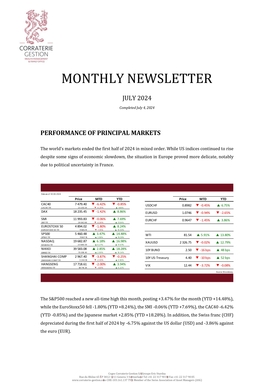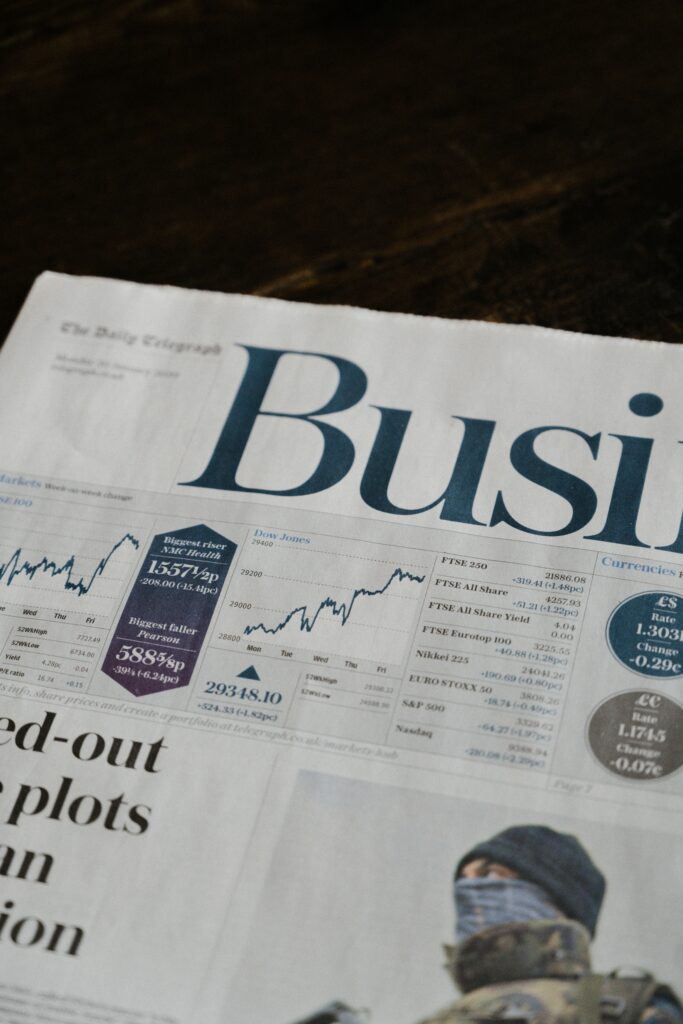1. PERFORMANCE OF PRINCIPAL MARKETS
The world's markets ended the first half of 2024 in mixed order. While US indices continued to rise despite some signs of economic slowdown, the situation in Europe proved more delicate, notably due to political uncertainty in France.
Kindly refer to the link at the bottom of the page to view the table.
The S&P500 reached a new all-time high this month, posting +3.47% for the month (YTD +14.48%), while the EuroStoxx50 fell -1.80% (YTD +8.24%), the SMI -0.06% (YTD +7.69%), the CAC40 -6.42% (YTD -0.85%) and the Japanese market +2.85% (YTD +18.28%). In addition, the Swiss franc (CHF) depreciated during the first half of 2024 by -6.75% against the US dollar (USD) and -3.86% against the euro (EUR).
2. ECONOMIC AND FINANCIAL ENVIRONMENT
The highlight of June was a political jolt in Europe, with elections to the European Parliament by almost 360 million citizens revealing a surge in right-wing parties, particularly in Germany and France. Stung, and in response to the defeat of his centrist party, President Emmanuel Macron surprised by immediately dissolving the National Assembly in an attempt to regain a new majority. Recent polls, however, suggest that this attempt may prove unsuccessful, as voting intentions seem to indicate that the Rassemblement National (RN) would come out on top, followed by the Nouveau Front Populaire, which brings together the left-wing parties France Insoumise, the Socialist Party, the Ecologists and the Communist Party, with the consequence of a likely lack of a majority that could lead to political deadlock. These uncertainties did not spare the performance of the French index, with the CAC40 losing -6.42% over the month, nor French treasury bonds (OATs), whose yields moved significantly away from German government bonds (Bunds), nearly 80 basis points (+0.8%), confirming investors' concerns.
In the United States, inflation indicators for May came in below expectations, giving investors cause for optimism. The consumer price index (CPI) remained stable for the first time since July 2022, at +3.3% for the year. Core inflation, which excludes the more volatile food and energy prices, meanwhile rose by +0.2% over the month and +3.4% year-on-year, the smallest increase since August 2021. While these figures are encouraging, certain weaknesses are beginning to emerge in terms of activity: the University of Michigan's consumer confidence index, an economic indicator measuring the degree of optimism among consumers regarding their finances and the state of the economy, fell to 65.6 in June, after reaching 69.1 in May and 77.2 in April. So, despite the lull observed in recent months on the inflation front, price levels still seem to be having an impact on the American consumer's appetite. On average, prices in the US have risen by +20% since February 2020, while wages have not risen as much.
Employment data for May show a further notable acceleration, with the creation of +272,000 non-agricultural jobs (NFP), surpassing the +165,000 recorded in April and the +190,000 expected. The majority of these new jobs were in the healthcare (+68,000), hospitality (+42,000) and administration (+43,000) sectors, which are heavily dependent on the US government's growing budget spending. The unemployment rate reached +4.0%, up from +3.8% in March and +3.9% in April, against a backdrop of a -0.2 percentage point drop in participation to 62.5%.
At its June meeting, the Federal Reserve (FED) unsurprisingly decided to keep its key rates unchanged. Jerome Powell was optimistic about the economy, while acknowledging that progress towards the +2% inflation target was too modest. The Fed's stance remains cautious, with only one rate cut expected by the end of the current year (down from three in March), preferring to wait for more convincing data before lowering its guard. In Switzerland, the Swiss National Bank (SNB) lowered its key rate by 25 basis points (bps), or -0.25%, to 1.25% for the second time, having already done so in March. This decision is in line with lower inflation forecasts but is probably aimed at preventing the CHF from strengthening in the face of political uncertainties in Europe. Finally, the European Central Bank (ECB) also cut its main key rate by 25bp to 4.25% in an environment characterized by stable inflation for several months, close to central bankers' targets, and an economy showing signs of weakness. This is the first time that the ECB has initiated a monetary easing cycle before the FED. It should also be noted that inflation in Canada and Australia has rebounded, contrary to expectations, underlining the importance of a degree of caution on the part of central bankers to avoid a scenario where inflation starts to rise again, as was the case in the 1970s when developed economies thought they had put an end to it.
The resilience of the US economy is underpinned by the disproportionate budgetary efforts of the administration led by Joe Biden, and the acceleration of federal indebtedness led by the current Treasury Secretary, Janet Yellen, ahead of the November presidential election. In this particular environment, it's hardly surprising that inflation is struggling to continue its downward trend. But perhaps this is simply intentional, since inflation is a means that requires little effort to limit growth or reduce the country's debt ratio!
3. OUR THOUGHTS AND ACTIONS
In the current environment, we are continuing with a neutral asset allocation, both in terms of exposure to risky assets and geographical spread. At the same time, with the interest-rate hike cycle coming to an end and geopolitical tensions still rife, we are maintaining our exposure to short- and medium-term investment-grade bonds, as well as to gold and oil.
4. THEME OF THE MONTH: THE US/CHINA TRADE WAR
The Sino-American trade war, started in 2018 by Donald Trump and continued since by Joe Biden's administration, represents a large-scale economic conflict that is disrupting the global economy. The United States and China, the two biggest economic powers, have thus entered a vicious circle by imposing reciprocal tariffs on thousands of products. This has led not only to major changes in supply and production chains, but also to inflationary pressures on the price of certain raw materials and consumer goods. This tug-of-war seems to have initiated a reconfiguration of the world's power blocs, creating uncertainty and opportunities for companies and investors alike.
In 2016, during the election campaign, Donald Trump seized on the subject of the trade deficit with China and China's growing economic ambitions, accusing the latter of unfair trade practices, such as export subsidies, intellectual property theft and forced technology transfer. His election was followed by the imposition of tariffs on numerous Chinese products, and other protectionist measures designed to defend American interests and protect against a country that aspires to become the world's greatest economic power and assert itself on the geopolitical stage, threatening the current supremacy of the United States.
More specifically, the major actions taken by the United States include imposing tariffs on hundreds of billions of dollars’ worth of products imported from China from 2018/2019, banning and adding Chinese companies to a blacklist restricting their commercial business in the United States, and, most recently, imposing tariffs of up to 100% on the import of Chinese electric vehicles. Although the US administration maintains that these measures are beneficial for the country, the economic data seems to prove otherwise. Moody's, for example, considers that such actions are inflationary and could negatively impact gross domestic product (GDP) by 0.6%, with a significant impact on the middle class.
There's no reason to believe that things will change in the near future, regardless of who the next American president might be (J. Biden or D. Trump), or even that current protectionism towards China will continue to strengthen. Paradoxically, even if these initiatives seem to have an adverse effect on the global economy, the progress of the energy transition or the preservation of the purchasing power of American citizens, it is interesting to note that they significantly benefit certain countries competing with China. Indeed, the tariffs applied to the latter now make the prices charged by certain countries more attractive, enabling them to gain a prime position in the reshuffling of production and supply chains. So-called "spectator nations" such as Vietnam, Mexico and South Korea are benefiting greatly from this fundamental change in the rules of world trade, especially as these countries have been able to adapt to improve their competitiveness, underlining the great growth potential of these often emerging countries in the years ahead.
To sum up, in investment terms, the US trade war is creating interesting medium- and long-term opportunities, which we are already taking advantage of through some of our investment vehicles, notably in Vietnam.




